Contents:
|
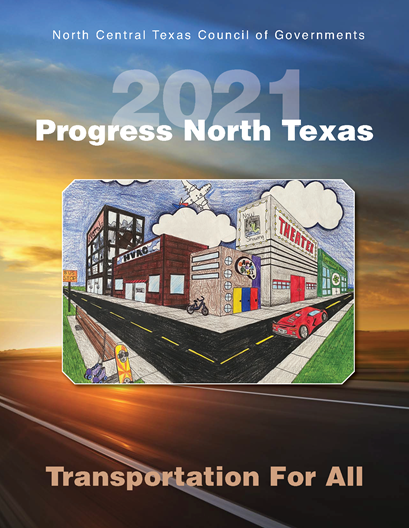
|
Dear Neighbors,
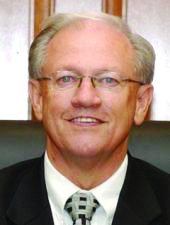
Thank you for reading Progress North Texas 2021. This year's theme is Transportation For All, which is especially appropriate as our region confronts the significant challenges posed by the COVID-19 pandemic.
Despite the difficulties we have all faced since March 2020, North Texas is showing signs of recovery, and there are reasons for optimism. While transportation was hit hard, our partners have made the necessary adjustments- just as everyone else has- to chart a course toward a brighter future. In the pages that follow, you will read how the roadways, public transit and air travel were affected by COVID-19.
You will also read about some positive developments in areas such as active transportation and system reliability, and how the region is coming together to solve problems. One of the great advantages of serving as chair of the Regional Transportation Council is I can not only experience but lead the cooperative decision-making that has defined our region.
I have witnessed my constituents benefit from this spirit of cooperation throughout my years as county judge of Johnson County. One of the most enduring examples occurred when transportation partners came together several years ago to agree on a plan to build Chisholm Trail Parkway from Cleburne to Fort Worth. Chisholm Trail Parkway stands as an example of how roadways can efficiently connect people. The roadway reduced travel times considerably and continues to serve as a magnet for both Johnson and Tarrant counties.
Transportation is most effective when its components work together. Our region also has growing transit and bicycle- pedestrian options that complement the roadway system to help keep the region moving.
I have long believed in the power of relationships and the partnerships that result from them. To get through this pandemic, we will need to continue to work together. I am pleased we are already seeing the results from many partnerships, whether it is part of the effort to reignite transit or taking advantage of lower interest rates to build infrastructure now that we will need as Dallas-Fort Worth continues to grow.
I encourage you to read this report and participate in the transportation planning process. Public involvement looks different these days, but your opinions are a necessary part of our recovery as a region. As we move beyond the pandemic and begin to gather again, the lessons we learned in 2020 will remain with us and lead to better days.
Roger Harmon
County Judge, Johnson County
Chair, Regional Transportation Council
The shift to working from home and gathering for virtual meetings during 2020 had a significant impact on the entire transportation system. The most profound changes were seen early in the pandemic, with the effort to stop the spread of COVID-19. Traffic counts fell 28% and 19% in April and May, respectively, according to data compiled by NCTCOG.

NCTCOG has undertaken the Changing Mobility initiative to monitor the impacts and assess the planning implications of the pandemic. The effort examines a series of policy metrics across transportation modes, from traffic volumes and travel behavior to funding implications and the prioritization of future transportation projects. NCTCOG provides regular updates to the Regional Transportation Council on the status of the recovery.
Speed
In 2020, the region saw a dramatic change in speeds during peak traffic hours in both morning and afternoon. In February, before pandemic restrictions, speeds slowed during both peaks. Under full restrictions in April, both peak periods saw faster speeds. By December, the afternoon peak speed had decreased again, but the morning speed remained higher. This indicates that while people returned to the roads, commutes were largely replaced by other trips during the day.
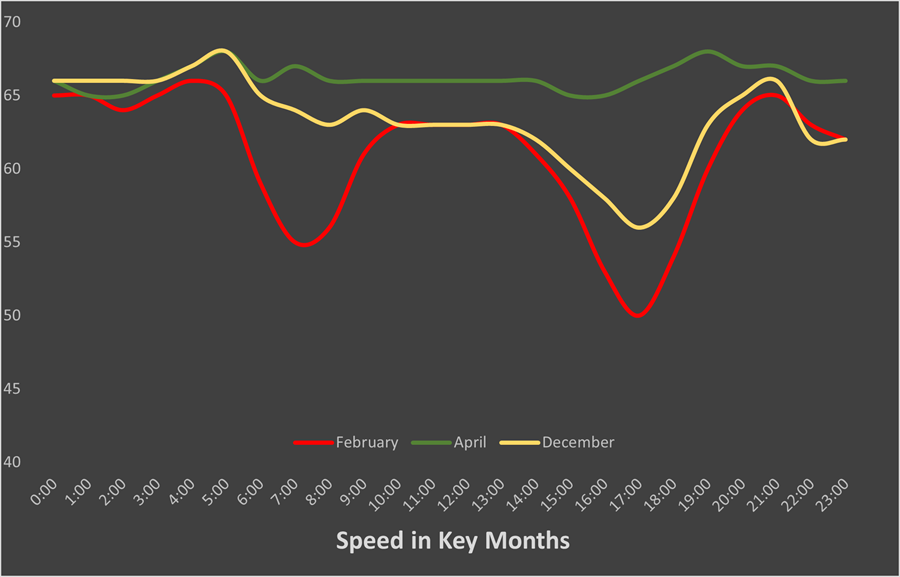 Although traffic speeds in North Texas increased after the initial restrictions were eased, data shows the distribution of traffic has not returned to normal. For example, morning traffic was still flowing more freely in December, indicating that longer commutes may have been replaced by shorter trips throughout the day.
Although traffic speeds in North Texas increased after the initial restrictions were eased, data shows the distribution of traffic has not returned to normal. For example, morning traffic was still flowing more freely in December, indicating that longer commutes may have been replaced by shorter trips throughout the day.
Compared with 2019, traffic on toll roads, which declined by 57% in the spring, gradually returned throughout the remainder of the year, and was down just 17% in December. Similar improvement was seen throughout the year with other modes of transportation and funding mechanisms. Motor fuel taxes, for example, recovered most of the losses experienced in spring 2020 with employers gradually bringing employees back throughout the year and travel picked up again.
Sales tax allocations to the region's three major transit agencies also showed substantial improvement by the end of 2020.
Traffic Congestion
North Texas' population continues to rise and now stands at more than 7.6 million. As a comparison with the region's population, congestion has remained relatively constant, thanks in part to significant transportation investments over the past 20 years. Those projects have helped commute times in the metropolitan area remain manageable, even before the pandemic. According to the American Community Survey, 72% of the commuters in the region spent less than 35 minutes driving to work in 2019.
According to TomTom, which provides traffic insights for more than 400 cities worldwide, the pandemic led to a decrease in congestion in 367 metropolitan areas, including North Texas. Drivers in the Dallas-Fort Worth area spent 13% more time in traffic due to congestion in 2020, down from 19% in 2019. Dallas-Fort Worth was 39th in the nation in congestion, despite being fourth in population.
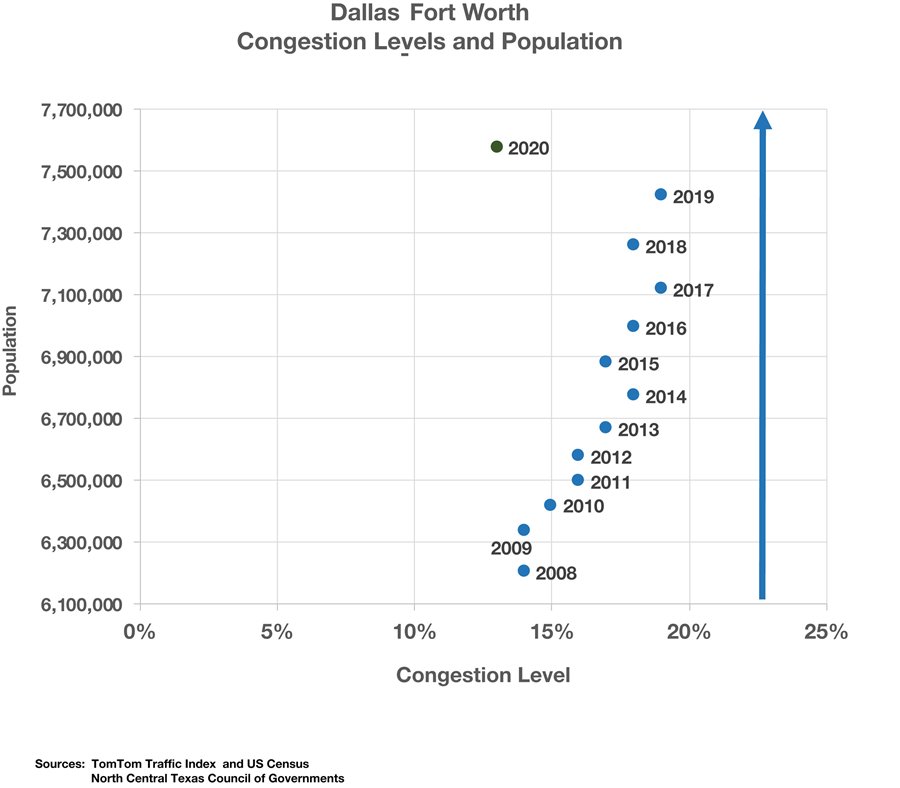 Congestion in 2020 declined to the lowest level in more than 10 years. According to TomTom, Dallas-Fort Worth is 39th in congestion, despite being the fourth-largest metropolitan area in the nation.
Congestion in 2020 declined to the lowest level in more than 10 years. According to TomTom, Dallas-Fort Worth is 39th in congestion, despite being the fourth-largest metropolitan area in the nation.
Congestion declined to levels not seen since the late 2000s, when the population was just over 6 million. The chart to the right illustrates the current congestion level as well as all levels since 2008. In the months and years to come, the transportation system will return to pre-pandemic levels. With a combination of good policies and strategic investments, the region can continue to move forward, accommodating the growing population and employment base of 5.3 million.
As the region begins to emerge from the pandemic and traffic patterns start returning to historical levels, the hope is some of the lessons of 2020 can be carried over. Maybe some work can continue to be done remotely, freeing up capacity across the transportation system and improving mobility. NCTCOG is working on an agency policy that would set a goal of reducing solo automobile commutes by 20%. Staff would not be limited to working from home. They could also carpool, take transit or work compressed schedules. This could serve as a model for other employers across the region, allowing more flexibility to the workforce and greater roadway capacity.
Back to top
Reliability is key to connecting people of all socioeconomic backgrounds with their everyday destinations, including their jobs, schools, medical appointments and entertainment centers. Whether adding new roadway capacity, managing the existing infrastructure, or improving and expanding other travel modes, NCTCOG and its partners are working to maintain an effective transportation network for all residents of North Texas.
Major projects continued to be advanced in 2020. Approximately $2 billion in transportation improvements went to construction during the year. In northern Tarrant County, a 7.2 mile project along Interstate Highway 35W from US Highway 81/287 to Eagle Parkway will result in the reconstruction of the main lanes of IH 35W and the addition of managed lanes. The project will enhance access to many major employment centers in the AllianceTexas area, as well as numerous other destinations in northern Tarrant and southern Denton counties.
In the eastern part of the region, work began on the 26-mile Dallas Area Rapid Transit Silver Line, which will provide direct passenger rail service from Dallas Fort Worth International Airport to Plano. Once the project is complete, residents will have another travel option for getting to and from numerous important destinations, including the University of Texas at Dallas and DFW Airport.
Transportation and the Pandemic
Transportation is playing an important role in the region’s recovery from the pandemic, just as it did during the Great Recession more than a decade ago. This is being accomplished through a mix of big ideas and smaller projects being pursued while the cost of borrowing is lower.

A $1 billion investment in infrastructure can result in an estimated 12,000-15,000 jobs created. Among the potential projects in Dallas-Fort Worth are high-speed transportation, autonomous transit vehicles, electric vehicle charging technologies and additional roadway capacity that could improve mobility along important corridors in North Texas.
The RTC is also funding smaller projects such as intersection improvements, roadway expansions and technological enhancements through the COVID-19 #00X Infrastructure Program. More than $435 million has been approved for over 50 projects throughout the 12-county Dallas-Fort Worth area. This can be tracked through the Changing Mobility dashboard at www.nctcog.org/pm/covid-19.
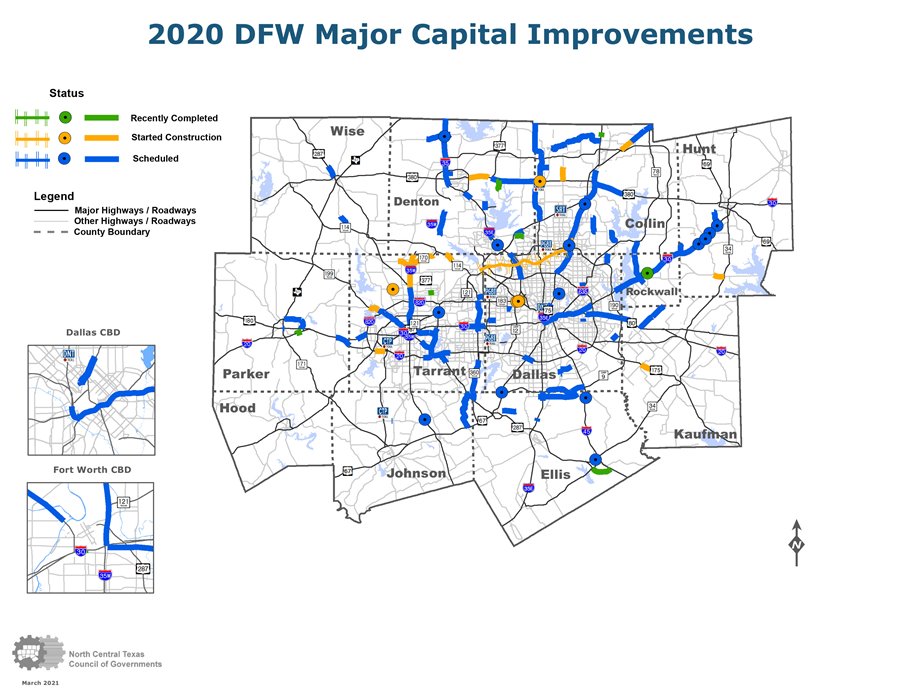 Construction on nearly $2 billion in transportation projects began in 2020.
Construction on nearly $2 billion in transportation projects began in 2020.
In the coming years, more major transportation projects are scheduled across the region. This includes the first phase of the Loop 9 project in southern Dallas and northern Ellis counties. This project will provide an additional way for North Texans, including many low-income and minority residents, to reach numerous major job centers in the Southern Dallas Inland Port.
In the western part of the region, the Southeast Connector project, which includes the reconstruction and widening of portions of IH 20, IH 820 and US 287 in southeast Tarrant County, is another major project that will improve mobility and safety.
Overall, NCTCOG and its partners anticipate spending $136 billion across all modes of transportation through 2045. This includes approximately $37 billion for infrastructure maintenance through 2045.
Pavement and Bridge Condition Measures
Federal rules require NCTCOG to monitor the condition of pavement and bridges along the region’s 12,000 miles of the national highway system as part of its performance measurement activities. These activities include either the adoption of unique regional targets or a decision to affirm and support statewide targets for these measures. In December 2020, the RTC voted to reaffirm Texas Department of Transportation targets for pavement and bridge condition. Policymakers will track and report the condition of the region's pavement and bridges as data is available.
NCTCOG has committed to plan and program projects that will improve pavement and bridge condition, including:
• Work with local governments to expedite improvements for NHS off-system arterials in “poor condition”
• Coordinate with TxDOT and local governments on improvements to NHS bridges in “poor condition”
An $8.8 million federal grant received in 2019 will help the region address seven bridges across Dallas-Fort Worth in poor condition. For more on the federal measures being collected, visit www.nctcog.org/pm/fed.
Environmental Justice Index
Historic discrimination contributes to current transportation challenges faced by low-income communities and people of color – groups protected by federal environmental justice requirements.
NCTCOG uses the Environmental Justice Index, an online tool supported by Census Bureau data, to identify these transportation challenges. Some of the questions being studied include:
• Do low-income residents face disproportionately long commutes or high transportation costs?
• Do people of color live in areas where a greater percentage of highway pavement is in poor condition compared with other areas?
• Do different communities face different air quality risks from the transportation system?
The outcome of this work will be considered in transportation planning activities and the selection of projects for funding.
The Environmental Justice Index data can be downloaded from: www.nctcog.org/EJ.
Back to top
NCTCOG and its partners work extensively to ensure the transportation system provides residents reliability and mobility as the population grows. Safety is an essential component of mobility in a system that seeks to connect all. North Texans drove fewer miles last year, with the pandemic dramatically affecting travel patterns, including daily commutes.

12-County Crash Totals
In 2020, the 12-county Dallas-Fort Worth area experienced 108,637 crashes, a 15% decline over 2019. Although crashes have decreased since 2019, fatalities increased 5% to 758 in 2020. This is due to people driving faster because of less congestion on roadways and the change in travel behavior during COVID-19 pandemic.
2020 Regional Crashes
| County |
Total Crashes |
Fatalities |
| Collin |
10,263 |
57 |
| Dallas |
48,141 |
307 |
| Denton |
9,543 |
55 |
| Ellis |
2,833 |
42 |
| Hood |
706 |
9 |
| Hunt |
1,367 |
24 |
| Johnson |
2,168 |
19 |
| Kaufman |
1,948 |
30 |
| Parker |
2,029 |
18 |
| Rockwall |
1,425 |
6 |
| Tarrant |
27,228 |
180 |
| Wise |
996 |
11 |
| Total |
108,637 |
758 |
Source: TXDOT
Traffic Incident Management
Increased training provided by NCTCOG helps agencies and first responders manage and clear traffic incidents more quickly, improving mobility on the roadways and ultimately saving lives. Traffic Incident Management training is regularly provided to local police, fire, wreckers, EMTs and courtesy patrol agencies. Regional coordination allows agencies to respond to crashes more efficiently, enhancing safety for the public and emergency personnel. Regional coordination allows agencies to respond to crashes more efficiently, enhancing safety for the public and emergency personnel. As a result, crashes can be cleared more quickly and upstream traffic collisions reduced. More than 3,200 emergency responders from 127 cities and counties throughout the region have completed the TIM training offered by NCTCOG.
Over $1.2 million was awarded through a competitive call for projects in 2020 to help cities and public safety entities purchase equipment and technology to help them mitigate traffic incidents in the region. The call for projects helped multiple jurisdictions with the cost of software, dynamic message signs, thermal imaging cameras and other equipment.
Commercial Vehicle Enforcement
Commercial motor vehicles that are overloaded or overweight can cause dangerous situations to arise on the roads in the region. Commercial vehicles operating outside of their designated size and weight limits take longer to stop and have more difficulty turning. These vehicles can also damage roadways and bridges. NCTCOG has purchased over 100 portable commercial vehicle weight enforcement scales to aid the region's commercial vehicle enforcement efforts. The equipment is designed to increase the enforcement of weight across region, increasing safety and saving money on roadway repairs and maintenance.
Mobility Assistance
In 2020, mobility assistance patrols helped over 126,382 motorists in North Texas get their vehicles moving again or provided protection to motorists and first responders. The Dallas and Tarrant County Sheriffs Offices manage these programs along interstate corridors in the four core counties. The North Texas Tollway Authority and private operators of LBJ Express and North Tarrant Express offer similar assistance on their roadways. Dallas County provided the most assists, followed by NTTA and Tarrant County.
Wrong-Way Driving
Wrong-way driving is among the most harmful activities on the roadways despite relatively few crashes occurring. In 2020, there were 545 wrong-way crashes in the 12-county region, with 86 of these crashes resulting in at least one fatality or serious injury. Due to the severity of these crashes, NCTCOG continues to work with the Dallas and Fort Worth TxDOT districts to execute the Wrong Way Driving Mitigation Program. This leads to the implementation of intersection, highway and technology improvements that help prevent wrong-way driving crashes and incidents.
Wrong-way driving is being addressed through strategies to replace conflicting lane and arrow markings, making signal enhancements and other intersection-related improvements in Dallas County and other cities across the region. Seven miles of freeway corridors in Tarrant County were addressed as part of the program. Some of the improvements made to help reduce wrong-way driving were radar, high-definition cameras and additional signage.
NTTA continues to use thermal imaging to detect wrong-way driving on the main lanes of its tolled facilities. Additionally, sensors in the pavement on entrance ramps are used to determine if a vehicle is traveling in the wrong direction. When this happens, automatic alerts are sent to NTTA staff, who notify law enforcement. NTTA also continues to add prevention measures such as flashing signs to correct a wrong-way driver’s behavior before they enter the highway.
Federal Safety Targets
NCTCOG met the federal safety targets in 2019 for fatalities, fatality rate and serious injuries. More work is needed to ensure progress continues. TxDOT has updated the statewide safety targets to be more in line with Vision Zero by 2035. The RTC has a policy statement saying that “even one death on the transportation system is unacceptable.” The goal of Vision Zero is to have zero fatalities resulting from roadway crashes.
| Safety Performance Measures |
2019 Target |
2019 Actual Performance |
| Fatalities |
599.2 |
557.2 |
| Fatality Rate |
0.838 |
0.781 |
| Serious Injuries |
3,999.60 |
3,692 |
NCTCOG has embraced a series of federal targets in an effort to reduce fatalities and serious injuries, which were met in 2019. Targets for 2021 are more stringent, as the region moves toward a goal of zero fatalities by 2035.
Back to top
Innovative transit options allow agencies to serve more riders and fill mobility and accessibility gaps, complementing traditional public transportation options. 2020 saw significant expansion of microtransit offerings, including on-demand service throughout the region.
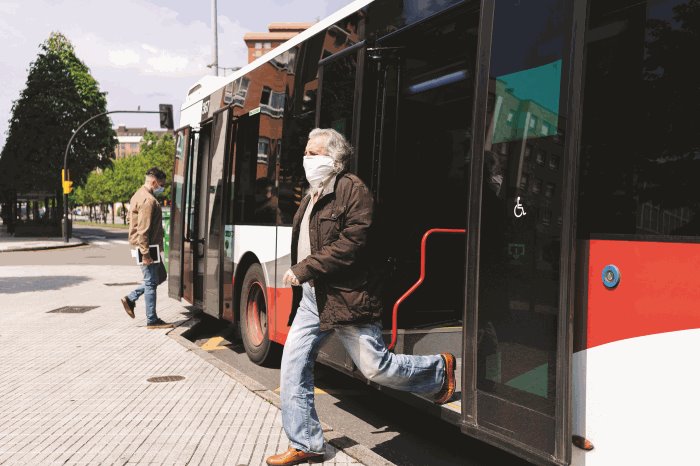
Via, the City of Arlington’s on-demand rideshare service provider, expanded its service area for the fourth time since its inception in January 2020 to cover approximately 41 square miles total. Later in the year, Arlington announced plans to expand service to the entire city. In March 2020, Arlington was also awarded $1.7 million from the Federal Transit Administration to integrate autonomous vehicles into Via’s service around Arlington’s downtown and the University of Texas at Arlington campus.
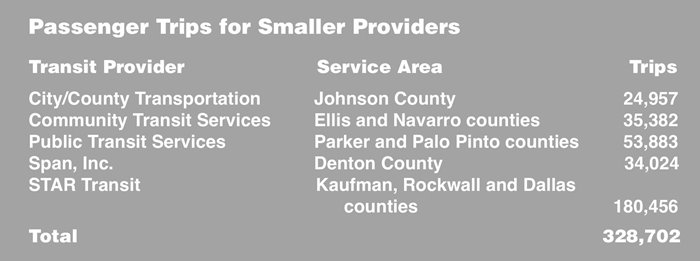
GoLink, Dallas Area Rapid Transit’s on-demand service, added zones in Southeast Garland, South Irving, the Inland Port and western Carrollton. The service now covers 16 total GoLink zones with more on the way. ZIPZONE, Trinity Metro’s on- demand service, added service in the City of Crowley and the Near Southside of Fort Worth. The Near Southside zone was expanded at the end of 2020 to provide additional coverage to allow neighborhood residents to reach medical facilities with ease.
While the major transit agencies continued to provide essential service, the region’s smaller providers were also connecting people to their destinations all over the region. These agencies combined to provide almost 330,000 trips in Fiscal Year 2020.
My Ride North Texas 2.0
Promoting mobility for all requires the strategic coordination of regional resources and partnerships. My Ride North Texas 2.0 is a mobility management program that seeks to improve the regional coordination of transportation services by expanding travel navigation. Funded through the FTA’s Innovative Coordinated Access and Mobility Pilot Program Grant, the program connects aging populations and individuals with disabilities to transportation services and informs regional medical trips through public transit.
Through a 24-hour, toll-free number, North Texans can reach a My Ride travel navigator who can provide personalized transportation counseling and advise callers of regional transportation options. NCTCOG partners with Community Council of Greater Dallas and My Health My Resources of Tarrant County to manage the program.
In 2020, the program’s travel navigators fielded more than 1,000 calls providing assistance for trips to medical, employment and social destinations for callers throughout the 16-county region. Partners also completed program outreach at 87 community, in-person and virtual events throughout the year to promote the program and raise awareness of regional transportation resources.
Supporting the Mobility of Essential Workers
The pandemic-influenced changes to how people work were reflected in the nearly 50% increase in telecommuting, as recorded by TryParkingIt.com, the region’s alternative commute and rideshare website. Although this represented a small sample percentage of the total number of people who worked from home, it helps tell the story. Still, many people across the region were required to commute to a physical workplace. Connecting these essential workers to employment destinations was perhaps more important last year than ever before.
The Regional Vanpool Program provides access to employment for workers making commute trips not served by other transit options. The program also reduces traffic congestion, improves air quality and lessens commute stress. In 2020, the program, which is operated by DART, Trinity Metro and Denton County Transportation Authority, combined to save approximately 15 million miles of travel on the roadway system. There are 133 active vanpools. The agencies have worked to maintain the viability of their vanpool programs during the COVID-19 pandemic while supporting the mobility of essential workers and initiating health and safety measures.
DART communicated regularly with vanpool groups promoting CDC guidelines and disseminating the FTA COVID-19 Resource Tool. Vanpool groups were provided cleaning kits and allowed to select larger vehicles at the same price as their original vehicle to promote social distancing. Trinity Metro ensured that all vanpool passengers had necessary PPE, such as face masks and hand sanitizer. In partnering with Commute with Enterprise, they ensured that participants were practicing social distancing by placing fewer people in each vehicle. Trinity Metro continues to work closely with Workforce Solutions and employers to raise awareness of the benefits of this service for essential workers.
| 2020 Regional Vanpool Performance |
| Regional Vanpool Program |
DART |
Trinity Metro |
DCTA |
Combined |
| Total Number of Vans (at year end) |
11 |
55 |
67 |
133 |
| Average Number of Participants per month |
331 |
475 |
386 |
1,192 |
| Total Van Miles Traveled (Annual) |
851,816 |
988,278 |
1,129,390 |
2,969,484 |
| Total Vehicle Miles of Travel Reduced (Annual) |
4,272,688 |
5,359,037 |
5,454,252 |
15,085,977 |
| Total Vehicle Trips Removed (Annual) |
139,834 |
208,184 |
230,678 |
578,696 |
| NOx Emissions Reduced (pounds) |
2,541.03 |
3,187.09 |
3,243.72 |
8,971.84 |
| VOC Emissions Reduced (pounds) |
847.01 |
1,062.36 |
1,081.24 |
2,990.61 |
The regional vanpool program remained a key component of the transportation system in 2020, helping people not working from home safely commute to their offices. The program helped reduce more than 15 million miles of travel. Sources: DART, DCTA, Trinity Metro
Transit Asset Management
NCTCOG is required by federal legislation to set regional transit asset management targets and evaluate performance of various transit assets annually in coordination with transit providers. The regional targets and tracking of transit assets focus on ensuring public transportation vehicles, rail lines and other capital assets are in a state of good repair. Overall, most regional targets are being met for many of the asset categories based on Fiscal Year 2019 data, with a few exceptions. Targets are established annually for these measures, and the next target-setting action is anticipated in 2021. For more information on Transit Asset Management, please visit www.nctcog.org/pm/fed.
Back to top
Active transportation stands out as one of the success stories of the pandemic, with bicycling and walking increasing by 50% in March 2020 and peaking in May 2020. Trail counts at sites around Dallas-Fort Worth reflect the growth in walking and bicycling. While trail use was up for walkers, joggers and bicyclists during the pandemic, bicycling experienced the biggest gains. Additionally, activity was up every day of the week, with the greatest increases occurring on weekdays. Furthermore, people walking and bicycling on trails during peak commuting hours increased by up to 120%.
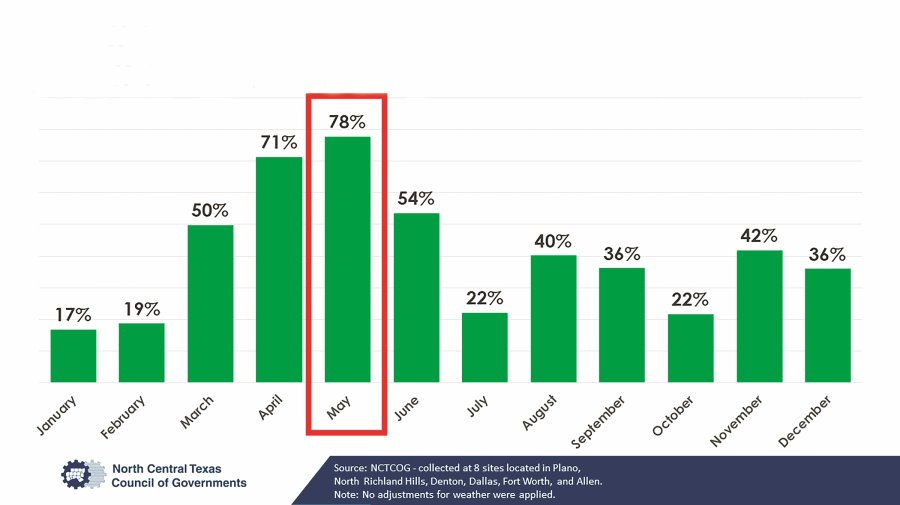 Activity on the region’s bicycle-pedestrian trails was up throughout 2020, after peaking in the spring.
Activity on the region’s bicycle-pedestrian trails was up throughout 2020, after peaking in the spring.
To help educate residents about available trails in their communities and throughout the region, NCTCOG completed a video series highlighting various regionally significant facilities. The videos spotlight trail corridors and amenities, current and future investment, the history of the trails and more. Eight videos were produced on trails in Collin, Dallas, Denton and Tarrant counties www.nctcog.org/bikeweb.
Creating Regional Connections
Connecting people to neighboring communities and destinations such as large employers, schools and transit is an important goal identified in Mobility 2045, the region’s long-range transportation plan. Closing gaps in the trail network could help active transportation continue to grow, even after the pandemic has ended.
NCTCOG has partnered with several agencies to complete preliminary design of trail segments that will improve connectivity. For example, the Cotton Belt Trail is being designed and will parallel the Silver Line commuter rail from DFW Airport to the future Shiloh Station in Plano. In southern Dallas County a regional trail alignment is being studied to connect Cedar Hill, Duncanville, DeSoto and Lancaster. Farther south, the Midlothian-to-Waxahachie Regional Trail will connect the two largest cities in Ellis County.
Trails are not the only facilities that need attention as part of the regional effort to improve connections for active transportation.
Two projects were funded with the help of the RTC’s Blue-Green-Grey initiative, intended as initial investment for innovative solutions that could be replicated throughout the region.
The Farmers Branch Green Bus Stop Design Guidelines Project is an example of a collaboration with DART and NCTCOG. It resulted in design guidelines that will reduce negative environmental effects and enhance quality of life, while increasing transit ridership and comfort. The Bicycle Parking Parklet Pilot Project repurposed two parallel parking spaces in the Dallas Bishop Arts District to accommodate bicycle parking and pedestrian seating.
Transit Oriented Development Planning
A Federal Transit Administration planning grant is helping NCTCOG and the region enhance transit accessibility and increase ridership and development around 28 Dallas Area Rapid Transit stations along the system’s Blue and Red lines. This includes the cities of Dallas, Garland, Plano and Richardson. Among the components completed as part of the grant in 2020 were a study of pedestrian connections to rail and a survey of residents' and businesses' perceptions of transit and urban development.
NCTCOG completed a study of pedestrian infrastructure needed to increase access to the DART stations. For streets within a half-mile radius of these stations, recommended improvements were identified and ranked based on the potential to improve pedestrian access. Estimated construction costs, primarily for new sidewalks and safety measures such as crosswalks and signals, and phasing for implementation were also developed.
 NCTCOG has completed a study of infrastructure needed to improve pedestrian access to DART rail stations as well as a survey of those who live and work near transit.
NCTCOG has completed a study of infrastructure needed to improve pedestrian access to DART rail stations as well as a survey of those who live and work near transit.
They provide a sense of who chooses to live and work near rail stations and their priorities and transportation preferences. For example, the study indicates 23% of people within a quarter mile of a station are likely to take transit. Conversely, only 7% of North Texans who live a mile from transit are likely to use it as a commuting option, according to the survey. This information will be key to future improvements, better informing the opportunities for local government policies and programs supporting TOD. The results of both studies can be found at www.nctcog.org/TOD.
Safe Routes to School
NCTCOG Is partnering with school districts to make sure students have safe connections to campus. Planners completed Safe Routes to Schools plans for five schools. In south Dallas, a plan was created for Salazar Elementary, Cowart Elementary and Stockard Middle School, located within a mile of one another. NCTCOG developed individual plans for Speer Elementary and Webb Elementary in Arlington. The plans outline arrival/dismissal procedures and infrastructure recommendations intended to increase student safety near schools.
Criteria for selection included:
• Greater than 80% of students designated as economically disadvantaged
• More than one crash in the school's vicinity
• Schools that have not previously received safe routes funding
For more information, visit www.nctcog.org/saferoutestoschool
Pedestrian Safety Action Plan
A regional Pedestrian Safety Action Plan was completed in early 2021 in response to the steadily increasing number of pedestrian fatalities across North Texas. Pedestrian fatalities in the region are above State and national averages since 2010. The Federal Highway Administration designated Texas, as well as Dallas and Fort Worth, as areas needing greater focus on pedestrian safety.
 NCTCOG has completed pedestrian safety plans for five schools in Dallas and Arlington.
NCTCOG has completed pedestrian safety plans for five schools in Dallas and Arlington.
Analysis of crash data indicates 80% of pedestrian fatalities occur in the dark. Of those incidents happening at intersections, roughly 70% of crashes occur when the pedestrian is in the crosswalk and the driver fails to yield the right-of-way.
The plan will guide improvements to The plan will guide improvements to pedestrian safety across the 12-county Dallas-Fort Worth area, incorporating policy recommendations aimed at reducing the overall number of reported crashes and fatalities involving pedestrians and motor vehicles. The plan also identifies targeted roadway corridors representing areas with high crash rates. The full Pedestrian Safety Action Plan is available online at www.nctcog.org/pedsafetyplan.
Back to top
The pandemic hit the region at the beginning of the 2020 ozone season. With the adoption of pandemic safety measures, such as telecommuting, the region’s transportation system saw less activity. As a result, transportation-related emissions were reduced but not by as much as expected.
NCTCOG works closely with its transportation partners to reduce emissions, protect residents’ health and comply with federal air quality requirements as it seeks to reach attainment for the Environmental Protection Agency’s ozone standards.
Currently, the region is working to meet two standards for ozone concentration, one established in 2008 (75 parts per billion), for which 10 counties are designated “nonattainment,” and one from 2015 (70 ppb), affecting nine counties. The region did not meet the standard in 2020 and was reclassified and given new attainment deadlines. With a combination of policies, programs and partnerships, NCTCOG will continue working to come into attainment.
Planners are analyzing other variables for rapid attainment. One factor being investigated is the interaction of nitrogen oxides and volatile organic compounds and its impact on ozone formation.
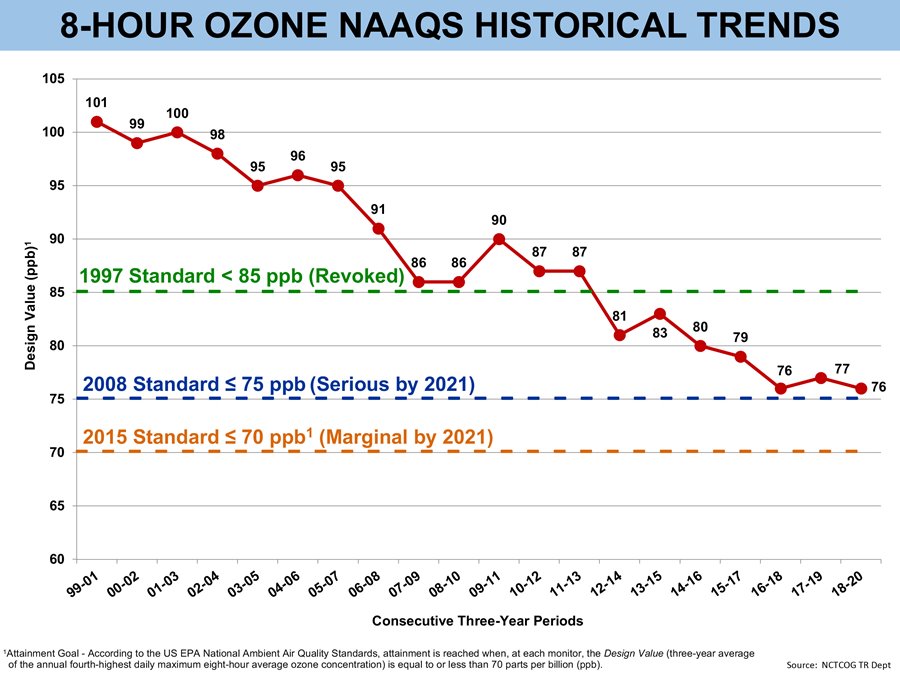 Ozone attainment is reached when the Design Value (the three-year average of the annual fourth-highest daily maximum eight-hour average ozone concentration) at each monitor is 75 ppb or less for the standard established in 2008. It must be at or below 70 ppb for the standard established in 2015.
Ozone attainment is reached when the Design Value (the three-year average of the annual fourth-highest daily maximum eight-hour average ozone concentration) at each monitor is 75 ppb or less for the standard established in 2008. It must be at or below 70 ppb for the standard established in 2015.
Mobile Sources
In 2020, light-duty vehicles (cars and small trucks) accounted for over 40% of on road NOx emissions and heavy-duty vehicles accounted for another 48% NCTCOG monitors NOx and VOCs closely as part of its commitment to track federal performance measures.
With the help of new projects implemented throughout North Texas, such as bicycle-pedestrian trails, intersection improvements and regional efforts to improve traffic signal timing, there has been a decline in NOx and VOCs. NCTCOG is working with partners to identify more projects that could allow this progress to continue.
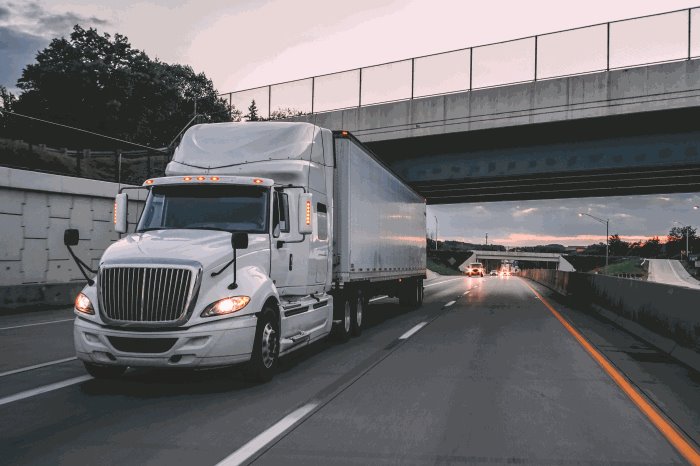
Electric Vehicles
Electric vehicles (EVs) and other alternative fuel vehicles can help improve regional air quality. EVs represent a growing sector in transportation and offer benefits to owners and the region. Regionally, EVs have grown substantially in recent years, from fewer than 300 in 2011 to 13,400 in January 2021.
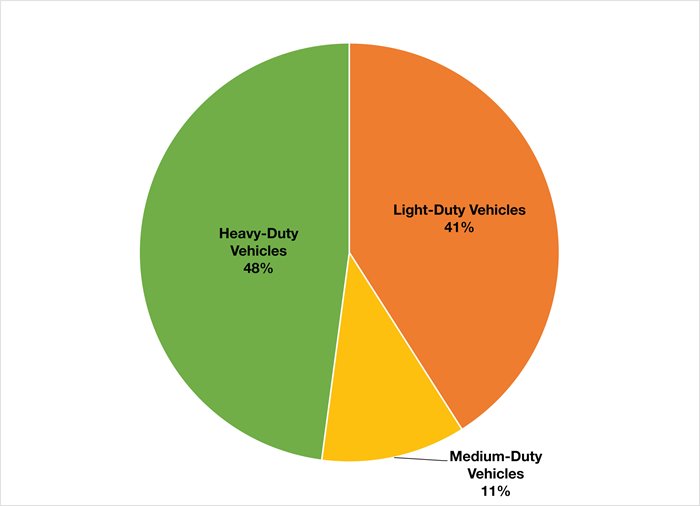
Reliability is also an issue planners are working to overcome. Entities across North Texas have built charging stations to allow EVs to get around. According to the latest estimates there are over 450 such stations in North Texas. The US Department of Energy’s Alternative Fueling Station Locator allows the public to search an interactive map for those locations. For access to the AFDC Station Locator and other EV information, visit www.dfwcleancities.org/evnt.
Zero Emission Vehicle Plan
Through the Zero-Emissions Vehicle (ZEV) Deployment Plan, NCTCOG is working with partners to strategically build out infrastructure along IH 45 to support battery electric (BEV) and fuel cell electric vehicle (FCEV) travel with a focus on supporting medium- and heavy-duty ZEV travel. NCTCOG is working with the Houston-Galveston Area Council and a group of stakeholders to advance this project. For more information, visit www.nctcog.org/IH45-ZEV.
Air Quality Health Task Force
The potential health effects of ozone are also driving the pursuit of cleaner air. NCTCOG initiated the North Texas Air Quality Health Monitoring Task Force in response to requests received from local governments concerning the impact of air pollution on public health, more specifically, transportation- related air pollution. The task force is made up of government representatives, health officials, academic representatives and air quality experts who meet quarterly to address concerns over localized air pollution. For more information, visit www.nctcog.org/aqhealth.
Air Quality Initiatives
A collection of air quality programs and initiatives help support emissions reduction efforts across the region. The primary focus is on light- and heavy-duty vehicles and equipment, which are responsible for most ozone-forming emissions.
Emissions Reduction Strategies
Engine Off North Texas connects the public with resources from local governments highlighting ordinances and policies that encourage heavy-duty diesel vehicles to reduce idling. North Texans can report excessive idling to NCTCOG through a hotline, which results in vehicle owners being notified. www.engineoffnorthtexas.org.
DFW Clean Cities Coalition
The Dallas-Fort Worth Clean Cities Coalition works to advance energy security, protect environmental and public health, and stimulate economic development with strategies to reduce transportation energy impacts and improve air quality. Its primary focus is in the transportation sector, collaborating with vehicle fleets to increase the use of alternative fuel vehicles, reduce idling and implement other fleet efficiency practices. DFW Clean Cities stakeholders save over 23 million gallons of gasoline each year. www.dfwcleancities.org.
Clean Fleet Policy Adoptees
Fleets are encouraged to adopt the RTC’s Clean Fleet Policy. This policy provides a framework for efficient and low-emitting operations, which helps the region work toward attainment of the federal ozone standard and improve overall air quality. Adopting the policy enables a fleet to apply for clean vehicle funding made available by the RTC. www.nctcog.org/fleetpolicy.
Try and Drive Alternative
The Try and Drive Alternative is a regional initiative dedicated to allowing fleets and
consumers to test alternative fuel vehicles and clean vehicle technologies. DFW Clean Cities connects alternative fuel technology providers with fleets and consumers for “test periods” with the hope of increasing the adoption of alternative fuel technologies and improving regional air quality. Technologies include telematics, alternative fuel vehicles, alternative fueling infrastructure and more. www.nctcog.org/dfwtrydrive.
NGV UP-TIME
DFW Clean Cities is partnering with Clean fuels Ohio to provide repair and maintenance data for an analysis project, natural gas vehicle (NGV) Updated Performance Tracking Integrating Maintenance Expenses (UP-TIME). This project will provide fleets and natural gas vehicle industry stakeholders relevant, real-world information about NGV maintenance costs. The project will help improve total cost of ownership calculations and determine the maintenance cost differences between NGV technology generations and current advanced clean diesel engines.
https://cleanfuelsohio.org/ngv-uptime/.
EV WATTS
The EV WATTS project was developed to address the need for practical information about vehicle electrification. Through this project, facilitated by Clean Cities and funded by the Department of Energy to Energetics, plug-in electric vehicle and electric vehicle supply equipment data is collected to analyze EV performance nationwide and help shape future EV research and development. Fleets and individual EV owners are eligible to participate.
www.dfwcleancities.org/evwatts.


Back to top
As the COVID-19 pandemic has demonstrated, the movement of goods, logistics and industrial production are critical assets to society and the lifeblood of the North Texas economy. NCTCOG has continued to analyze the network of highways, railroads, warehouses and other freight facilities to determine how they impact nearby properties and communities.
Major milestones toward the completion of the Freight Land-Use Analysis were reached in 2020. These include the Freight Facility Environmental Justice Analysis, which provided valuable insights into how low-income and minority communities are affected by freight-focused infrastructure.
Additionally, a Freight Land-Use Preservation Analysis was conducted to determine how freight facilities in the region have changed over time, as well as how industrial land development patterns have been affected by economic trends such as e-commerce and just-in-time supply chain practices.
The land-use analysis is anticipated to be completed in 2021 and will include a policy toolkit that cities can use when planning for new freight land-use development. The toolkit will also explain how to protect and preserve existing freight infrastructure and the surrounding communities, by ensuring they act as “good neighbors.”
BUILD Grant Award
The Council of Governments was awarded $25 million through the 2020 Better Utilizing Investments to Leverage Development (BUILD) grant program to double track more of the Trinity Railway Express Corridor. Known as North Texas MOVES (Multimodal Operations Velocity, Efficiency and Safety), this initiative will allow trains to continue moving, eliminating much delay.
The program focuses on improving freight and passenger rail movements across the region, providing significant relief to congestion, while boosting regional air quality and safety along the TRE corridor. This corridor is important to both passenger and freight rail. It is used by TRE regional rail service, Amtrak and freight carriers. With so much activity, it is important to keep up with current and future demand to improve rail efficiency in the region. Currently, 20 of the 35 corridor miles are double tracked.
Double-tracking increases rail capacity and improves efficiency, reducing congestion along the corridor. To maintain smooth passenger and freight movement, an additional 3.6 miles of double track needs to be added. Such an upgrade will allow trains to continue moving, eliminating much delay and allowing more capacity.
Specifically, the improvements include 1.2 miles of double- tracking from the Medical Market Center station to the Stemmons Freeway railroad bridge in Dallas, 2.4 miles of double-tracking from Handley Ederville Road to Precinct Line Road in Tarrant County and implementation of a rail technology called the Regional Railroad Information System (RRIS). This technology promotes network efficiency and improved information helps partners understand the benefits of potential projects.
The project will also include replacing or rehabilitating aging bridges that now result in speed restrictions. Once the $55 million project is complete, the corridor will have just 11.4 miles of single tracking. The results will be reduced congestion and increased efficiency and capacity in the area.

Truck Travel Time Reliability
Truck Travel Time Reliability is a federal performance measure NCTCOG must track. This assessment requires two- and four-year targets and is reported every two years. Travel time reliability addresses how much time it should take truck drivers to reach their destination. If they accomplish this on time consistently, this demonstrates how reliable the road network is for truck traffic.
Travel time reliability establishes the amount of time a truck driver needs to add to a median trip length to arrive on time. The lower the number, the better the travel time reliability. For example, if the rating is 1.5 and a trip takes 60 minutes under normal conditions, drivers will need to plan 90 minutes to arrive on time.
Travel time in North Texas has increased in recent years, despite an improvement experienced during the pandemic. In 2017, the measure for the region was 1.73. By 2019, it had climbed to 1.82. The current reliability goals for 2020 and 2022 are 1.83 and 1.90 respectively.
Although COVID-19 has improved predictability, the effects are not expected to last. However, when tracking travel time reliability over the next four years, it will be important to consider the impact of the pandemic and other major events.
There are a few ways to help improve truck travel time in the region. They include reducing truck bottlenecks, improving travel-demand management and addressing truck parking needs throughout North Texas. NCTCOG encourages educating elected officials and the public regarding freight’s role in the success of the region. Staff also supports enhanced system planning within the freight industry to improve delivery time reliability. For more on travel time reliability, visit www.nctcog.org/pm/fed .
Grade Crossing Incidents
There are over 2,900 at-grade railroad crossings in the region. It is important for North Texans to follow proper safety precautions near crossings. Since 2000, when there were 67 grade-crossing incidents in North Texas, the number of incidents has been trending downward. In 2020, there were only 31 incidents recorded, 20% fewer than the year before. The following illustration represents the downward trend.
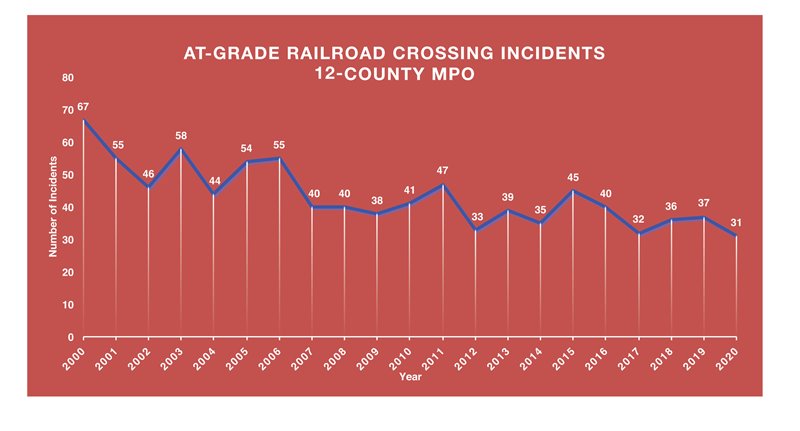 North Texas experienced another drop in incidents at rail crossings in 2020.
North Texas experienced another drop in incidents at rail crossings in 2020.
Back to top
COVID-19 had a significant effect on the aviation industry, with a prolonged reduction of both business and leisure travel making the pandemic one of the most difficult chapters in aviation history. Commercial flights in North Texas began to rebound by the end of the year, but it will take time to recover to pre-pandemic levels. Dallas Fort Worth International Airport, for example, transported 39 million passengers, a decline of nearly 50% from the previous year. However, changes in travel patterns during the early days of the pandemic resulted in DFW Airport briefly becoming the world’s busiest airport.
Sectors of the aviation industry, such as general aviation and air cargo, performed well after COVID-related travel restrictions were imposed. Federal Aviation Administration data from North Texas general aviation airports shows operations initially fell in early 2020, but picked back up during the summer, due in part to an increase in the use of private planes.
 Cargo activity at Fort Worth Alliance Airport increased in 2020, a bright spot during the pandemic that could be partially attributed to the presence of the new Amazon hub at the airport. DFW Airport saw a decline in cargo transported.
Cargo activity at Fort Worth Alliance Airport increased in 2020, a bright spot during the pandemic that could be partially attributed to the presence of the new Amazon hub at the airport. DFW Airport saw a decline in cargo transported.
North Texas general aviation airports received $20.5 million in grant funding in 2020, allowing them to cover operations costs when traffic slowed significantly at the beginning of the pandemic, while also continuing with key airport improvement projects.
Air cargo was another area that showed promise in 2020, experiencing revenue growth of $15 billion worldwide compared to 2019. The need to move more personal protective equipment and supplies to support the COVID-19 response, which planes could do quickly, also created additional cargo demand. And with the development of COVID-19 vaccines and the need to deliver them long distances, an opportunity opened for companies that transport goods through the air.
DFW Airport and Alliance Airport, the regional leaders in air cargo, experienced different results in 2020. While DFW Airport saw an 11.5% decrease in cargo transported, Alliance showed a 76% increase, primarily due to Amazon’s large cargo facility at the airport, which the e-commerce company debuted in 2019.
Daily traffic at DFW Airport and Love Field decreased significantly in 2020. DFW daily flights declined from 1,973 in 2019 to 1,406 in 2020. Love Field’s daily flight decline was similar, going from 635 in 2019 to 465 in 2020. The region continues to have adequate airspace capacity. Together, the airports have the combined ability to operate more than 5,100 daily flights. The declines in operations are specifically attributed to the pandemic and are forecast to recover in the coming years.
UAS Growth
Unmanned aircraft systems, commonly called drones, represent another growing sector of the aviation industry. The UAS market grew by approximately 8.5% in 2020, according to FAA estimates.
According to the FAA, there are approximately 870,000 registered drones in the US. Commercial drones make up 44% of the market, while recreational drones make up 56%. Improved technology such as longer battery life, integrated cameras and user-friendly apps for phones and tablets has helped make drones more affordable.
 Steep declines in air travel caused by the coronavirus pandemic began to stabilize by the end of 2020.
Steep declines in air travel caused by the coronavirus pandemic began to stabilize by the end of 2020.
UAS Rules
The FAA has also updated the rules of flight, including allowing a drone to provide identification and location information that can be seen by others. Another rule passed in 2020 pertains to operation of drones over people and at night.
The rule allows for the operation of small UAS at night under two conditions:
• The remote pilot must complete an updated initial knowledge test or online training
• The small unmanned aircraft must have anti-collision lighting visible for at least three statute miles
UAS Workshops
NCTCOG is working with regional partners to ensure this growing technology can be effectively integrated by users and solutions to problems can be developed. This is being accomplished through various means including a UAS Task Force, working groups and collaboration with regional stakeholders.
To provide more experience for drone operators, NCTCOG offers free workshops. Due to COVID, these are being held virtually on the first Saturday of each month. The workshops will continue through 2022 and cover rules both hobbyists and professional operators should know. They will also feature speakers who can discuss trends and changes in the industry and explain how they affect operations in the region.
For more information and to register for an upcoming workshop, visit www.northtexasuas.com. Links to the recordings of previous workshops are also available on the site.
Back to top
Moving the Dallas-Fort Worth area forward entails creative approaches to regional transportation issues.
Although traditional infrastructure projects and maintenance are essential for the continued success of the region, technology can play an important role in the implementation of strategies across all modes. Finding solutions that will benefit residents no matter where they live and, the workforce to implement them, could be easier with a new research partnership involving local universities.
Mobility Technologies
NCTCOG partnered with the Texas Research Alliance and four area universities in 2020 to establish the North Texas Center for Mobility Technologies. The University of North Texas joined the University of Texas at Arlington, the University of Texas at Dallas and Southern Methodist University to supply the region’s employers with the talent and research capacity needed to continue to be leaders in transportation innovation.
This partnership is intended to strengthen the universities’ capabilities in the transportation sector and to attract mobility technology companies to the region. The North Texas Center for Mobility Technologies will provide a research and development network consisting of mobility companies, cities, and public agencies and use the network to attract industry and academic talent.
Aided by an initial investment of $2.5 million from the RTC to help fund sponsored research projects, the center will focus on projects that seek to accomplish the following:
• Address mobility challenges
• Contribute to economic development and jobs
• Provide mobility models that help address regional environmental concerns
• Provide mobility solutions for underserved communities
• Demonstrate technology leadership
SM Wright Grant
Technology can help connect people to neighborhoods, businesses and other destinations. That is what is happening in one southern Dallas corridor. The City of Dallas secured a $4 million federal grant for transit and bicycle- pedestrian improvements intended to enhance comfort, safety and reliability in the SM Wright corridor.
Built decades ago during the Urban Renewal era, highways like SM Wright have sometimes divided low-income and minority populations. This project highlights the use of technology in reconnecting neighborhoods and creating areas that are welcoming to residents. Contributions from Dallas and the RTC will provide an additional $4 million for the project. The current six-lane divided freeway and access roads are being replaced by a six-lane arterial boulevard.
Intersection enhancements along SM Wright will include technology extending green lights for transit vehicles, allowing transit passengers improved reliability through the area. Buses using this corridor will be equipped with technology that improves safety for bicyclists and pedestrians, through a system of camera-based smart sensors around the buses and intersections. This technology monitors the driving environment and warns the bus drivers of pedestrians and cyclists.
Optimization
Another example of using technology to improve connectivity can be seen in the DFW Freight Optimization Program. This effort, which launched in 2020, aims to use technology applications at traffic signals to improve the flow of freight between freight hubs and expressways.
Automated Vehicles 2.0
Automated Vehicles 2.0 provides cities and other public entities with resources to partner with developers of the technology. The funding for this initiative, established in 2018, consists of three parts:
• AV 2.1: Assists public entities planning for the deployment of AVs in their communities
• AV 2.2: Helps public entities cover infrastructure, equipment, safety, public education and other costs incurred when an AV deployment comes to a community
• AV 2.3: Provides support for AV deployment projects supporting use cases/ communities that have not attracted AV developer interest but offer an opportunity to improve transportation reliability
NCTCOG hired a consultant in 2020 to develop a planning framework to prepare for increased vehicle automation as part of AV 2.1. The consultant will conduct outreach and engagement, and explore technologies and potential scenarios to establish regional guidelines that can used for deployment.
Work also continues on AV 2.2 and AV 2.3 as planners look to the future of vehicle automation and how it might help improve mobility and reliability through the elimination of transportation bottlenecks.
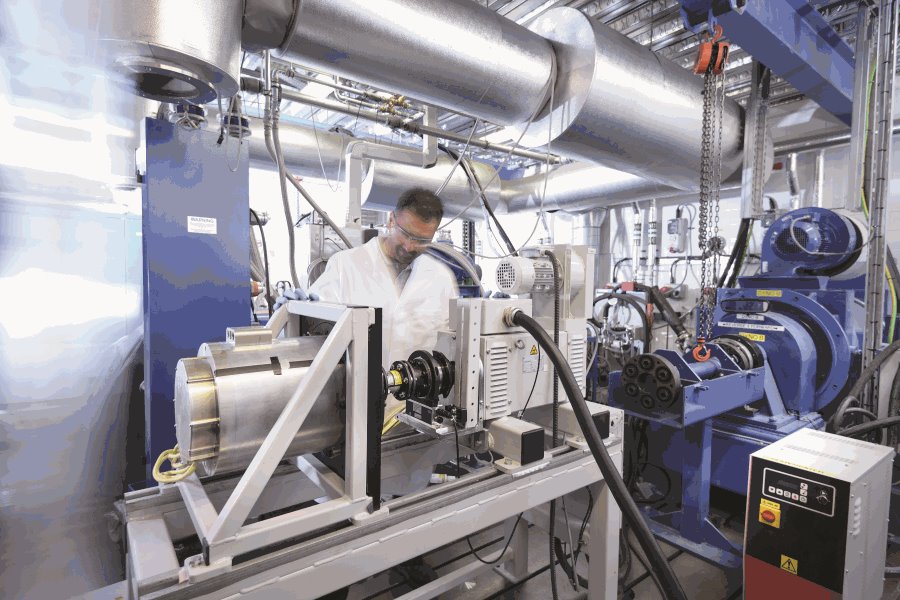 North Texas policymakers and transportation planners have embraced technology as a tool to to help the region serve its residents efficiently. The new Center for Mobility Technologies will strengthen participating universities' transportation capabilities while providing innovations that could make Dallas-Fort Worth an industry leader
North Texas policymakers and transportation planners have embraced technology as a tool to to help the region serve its residents efficiently. The new Center for Mobility Technologies will strengthen participating universities' transportation capabilities while providing innovations that could make Dallas-Fort Worth an industry leader.
Automated Transportation System Development
Additionally¸ NCTCOG selected a consultant in spring 2021 to develop performance guidelines for an Automated Transportation System. The guidelines will shape future engineering procurements for the use of automation to move freight and people.
High-Speed Transportation
Progress continues on another innovative transportation option that could revolutionize how people travel across the region and State. The Dallas-Fort Worth High-Speed Transportation Connections Study is evaluating high-speed alternatives to modernize and enhance mobility between Dallas, Arlington and Fort Worth. Planners are considering conventional high-speed rail and hyperloop technologies.
NCTCOG held virtual public meetings in September, allowing residents to safely provide feedback on this project during the pandemic. Virtual public involvement continued into 2021, with a goal to identify technologies and routes for further study. The resulting high-speed service between Dallas and Fort Worth could connect residents throughout the region to high-speed rail under development between Dallas and Houston and a future high-speed option from Fort Worth to South Texas.
Through research and the deployment of the resulting transportation technologies, North Texas can continue to efficiently connect people to important places, regardless of how they choose to get there.
Back to top
When the coronavirus pandemic set in, it quickly became apparent to the North Central Texas Council of Governments and other organizations that in-person meetings and events would have to be postponed or canceled to keep the public safe. It didn’t take long to realize the pandemic was going to last months. Event postponements became cancelations, as Dallas-Fort Worth and the world shifted from in-person to virtual gatherings.

While video meetings lack the personal touch most people embrace, the change was necessary. And NCTCOG was prepared. The Regional Transportation Council’s meetings were exclusively streamed live on the internet beginning in April 2020, and public meetings were modified so residents could watch presentations from the safety of their homes and provide comments directly to NCTCOG staff without attending a meeting.
| Top Five Social Media Topics |
| Topic |
Reach |
Share of Reach |
| Air Quality |
97422 |
22.3% |
| Other (special days, holidays or other non-transportation-related posts) |
70738 |
16.2% |
| Bike |
56436 |
12.9% |
| Public Meetings and Events |
53910 |
12.4% |
| Transit |
45048 |
10.3% |
These are the five most engaging topics covered on the department’s Facebook and Twitter pages in 2020.
The streaming of RTC meetings is not new. The policy board’s sessions have been available online for several years, allowing residents and business leaders to monitor the decision-making process without having to travel across town. But with no in-person meetings, viewership increased substantially. Unique views of the RTC’s online meetings increased by an average of 220% in 2020.
The pandemic put more emphasis on technology across the board. Since staff members could not attend back-to-school events or community festivals, they had to use other means to encourage involvement. Some events, such as the local celebration of National Drive Electric Week, which NCTCOG has historically coordinated, went entirely virtual. Although this created a different experience, it allowed the region to remain involved while it was not safe to gather in large groups.
Tools such as Map Your Experience gave residents a voice while they focused on keeping themselves and their families healthy. Map Your Experience gathers continuous input from the users of the transportation system, which NCTCOG can use to collaborate with partners and develop innovative solutions for transportation issues in the Dallas-Fort Worth area. It will also provide a model for future public engagement. To learn more and to provide input, visit www.nctcog.org/mapyourexperience.
 Virtual meetings helped people throughout Dallas-Fort Worth stay connected with transportation planners in 2020.
Virtual meetings helped people throughout Dallas-Fort Worth stay connected with transportation planners in 2020.
Public meetings were also reimagined in 2020, with staff moving to online input opportunities, allowing residents to remotely view and comment on presentations about transportation and air quality topics. For example, the Department conducted public meetings on the DFW High-Speed Transportation Connections Study, which is examining potential technologies to link the Dallas- Arlington-Fort Worth corridor. Online video-conferencing tools are likely to remain an integral part of NCTCOG’s outreach strategy long after it becomes safe to gather in person again.
The Department’s social media presence also helped it stay connected to people in 2020. The number of followers on Facebook and Twitter increased to approximately 9% in 2020. The most engaging posts in 2020 were related to bicycle-pedestrian activities, enjoying a 4% engagement rate. Air quality posts were the top messages by reach, with bicycle-pedestrian posts ranking third.
Media relations is also an important outreach tool for the Department, as it allows staff to directly interact with reporters to deliver the information on transportation and air quality to a much larger audience. The Transportation Department distributed 23 press releases, and staff participated in approximately 50 media interviews in 2020 on topics ranging from the coronavirus pandemic and its effect on transportation to technology and innovation. There were also over 160 mentions of NCTCOG in media reports.
While there is no substitute for meeting in person, the virtual environment is another way NCTCOG can involve people in the transportation planning process. The Department continues to look for ways to engage with residents and partners to find cooperative approaches to meet the unique challenges of the growing region and provide transportation for all.
Back to top
 As we are set to publish this year’s edition of Progress North Texas, I can’t help thinking how different things feel compared to 2020. Yes, the pandemic has stretched further than we had imagined last spring, when we were all asked to make sacrifices to slow the spread of COVID-19. But we were still trying to navigate a path forward at that point. Now, we have a vaccine. And chances are, if you have chosen to be vaccinated, you at least have received your first shot. As we head toward the summer, I see tremendous hope. To be sure, we have experienced terrible loss. I do not mean to minimize what a difficult year-plus it has been. But thanks to the care we’ve taken to follow CDC protocols and the distribution of the vaccine, there is a bright light ahead. The North Central Texas Council of Governments will continue working with our valued partners at the local, State and federal levels to ensure transportation does its part to lead us all into that bright light.
As we are set to publish this year’s edition of Progress North Texas, I can’t help thinking how different things feel compared to 2020. Yes, the pandemic has stretched further than we had imagined last spring, when we were all asked to make sacrifices to slow the spread of COVID-19. But we were still trying to navigate a path forward at that point. Now, we have a vaccine. And chances are, if you have chosen to be vaccinated, you at least have received your first shot. As we head toward the summer, I see tremendous hope. To be sure, we have experienced terrible loss. I do not mean to minimize what a difficult year-plus it has been. But thanks to the care we’ve taken to follow CDC protocols and the distribution of the vaccine, there is a bright light ahead. The North Central Texas Council of Governments will continue working with our valued partners at the local, State and federal levels to ensure transportation does its part to lead us all into that bright light.
-Brian Wilson
Communications Supervisor NCTCOG
2021 Art Contest Participants
This year, we were pleased to open our annual art contest to Cleburne ISD. Congratulations to Angie Andersen, the winner of this year’s competition. We asked the students to illustrate what this year’s theme of Transportation For All means to them. Angie’s artwork is on the cover of Progress North Texas 2021.
Art Contest Winners
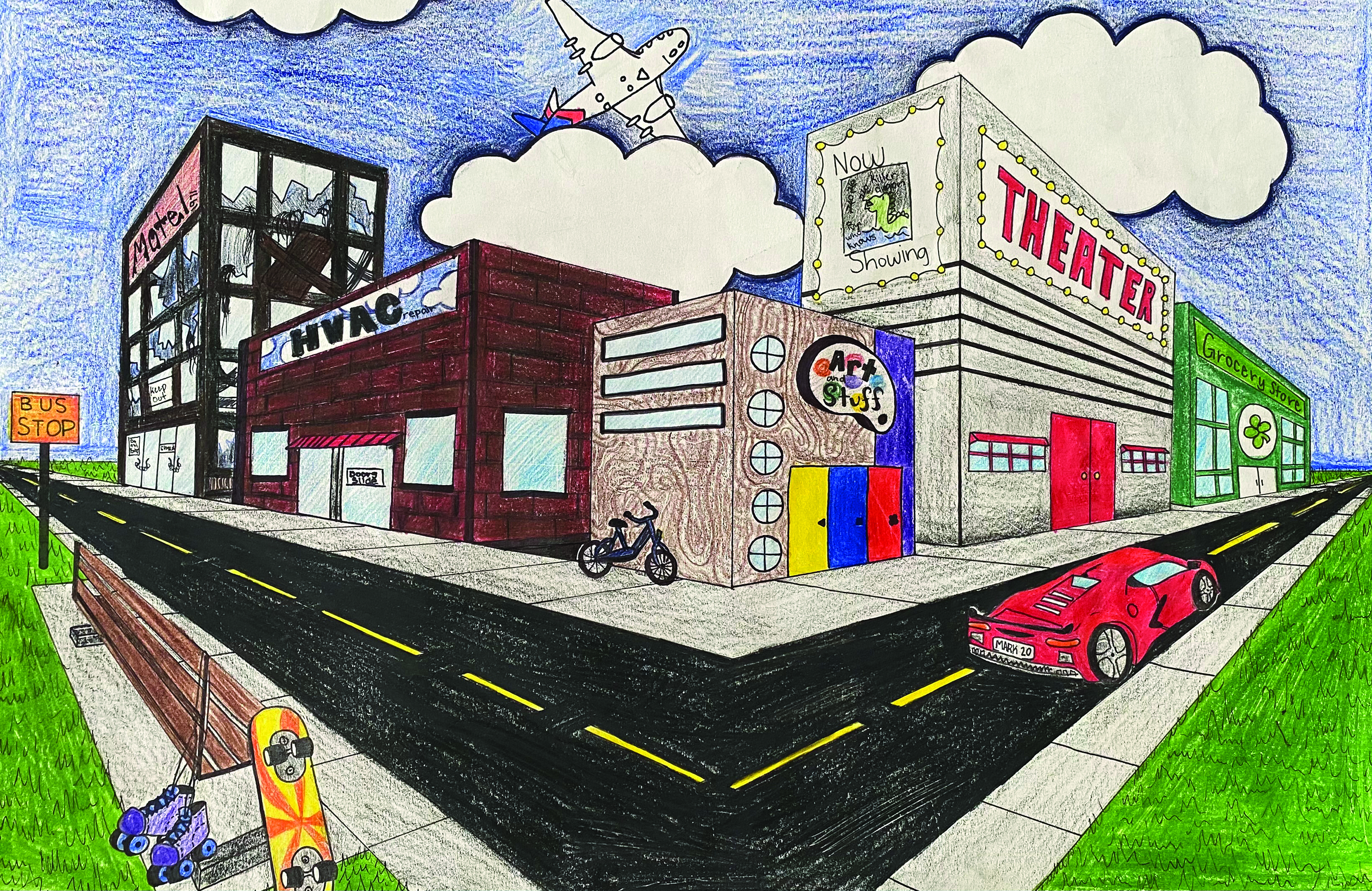 |
 |
Angie Andersen
10th grade
Cleburne High School
Teacher: Ms. Raigan Swaim |
Jeremy Pugh
9th grade
Cleburne High School
Teacher: Ms. Raigan Swaim |
All graphics are from NCTCOG, and all photos are from Getty Images, unless otherwise indicated.
Back to top